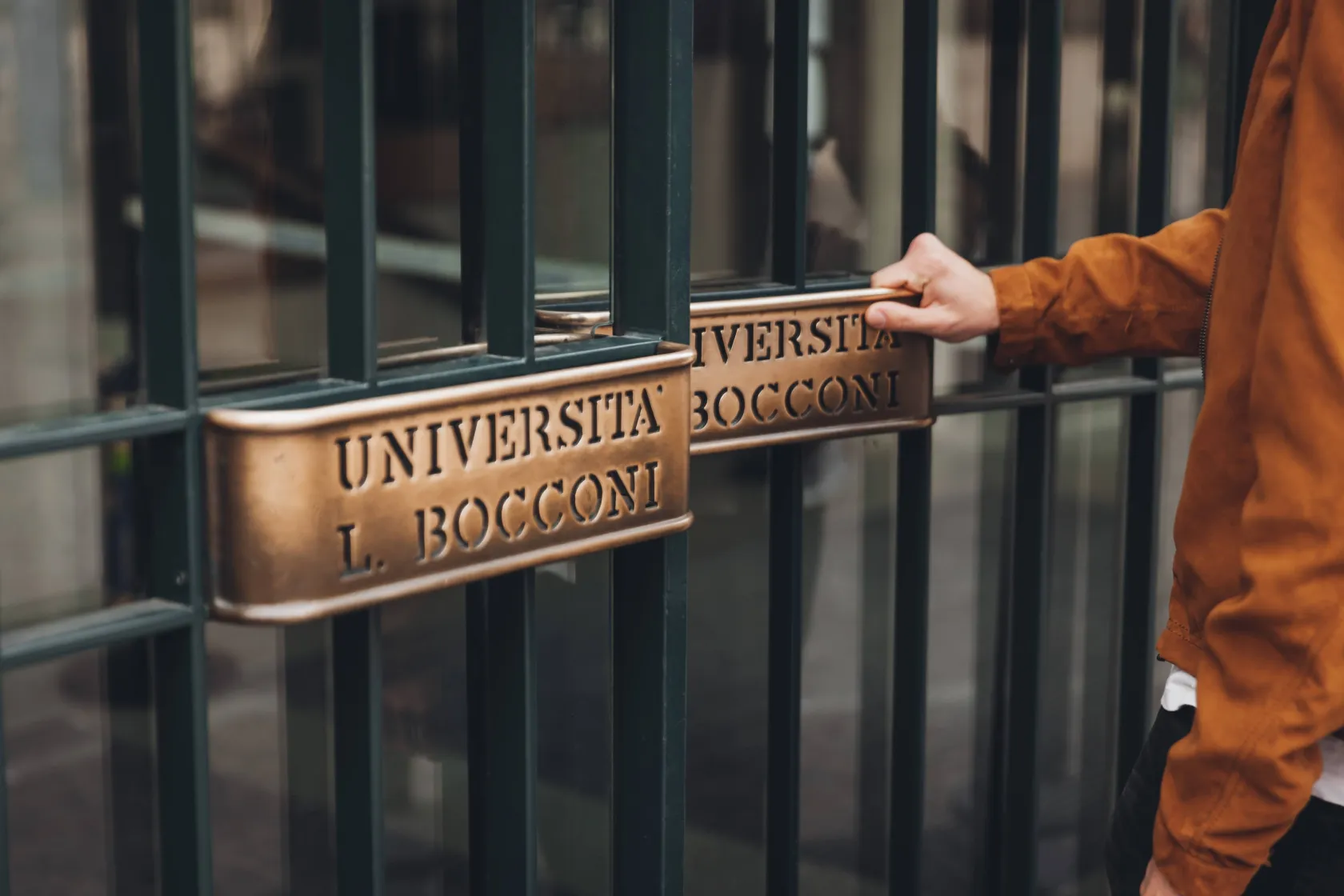
Social Mobility Starts at School. And Then Goes to College
The difference lies entirely between the concept of ascription and that of achievement. That is, between a society in which the social class of birth is what counts (ascription) and one where initial status does not count and everyone can achieve the goals they desire (achievement). "The concept of social mobility lies in the transition from one to the other," explains Demographer and Bocconi Rector Francesco Billari. “The development of education as a powerful engine of social mobility, first through compulsory schooling and then through university studies (see the latest U7+ statement), is evidence of this trend. The duty of a democratic system is to give everyone the same opportunities knowing that starting conditions are not equal. Thus the issue of removing obstacles to higher education." Obstacles that are sometimes economic (and which Bocconi helps to overcome through the Bocconi4Access to Education system of financial aid), and sometimes take the form of stereotypes and prejudices linked to one’s gender or background of origin. However, they all produce an impact on the educational experience of students. As the studies of Bocconi researchers show, the transition between middle school and high school, in particular, and the one between high school and college, represent the two crucial moments in which these obstacles are found, something that risks slowing down the kind of social mobility that university education should promote.
The first key step is the one that sees teens struggling with choosing the right kind of high school, a choice that will have fundamental consequences on their future. Pamela Giustinelli, Assistant Professor at the Department of Economics and an affiliate of Bocconi LEAP (Laboratory for Effective Anti-Poverty Policies), whose research has focused precisely on this delicate phase of one’s personal development, is very clear: "The choice of the type of high school has an impact on the options, the actual choices and future outcomes of a person in terms of both study and work,” she explains. “It is truly a crucial moment, perhaps even more so than the moment of choosing one’s university program.” In fact, it is the moment in which most Italian girls and boys decide their future, because depending on whether they choose a lycée, a technical institute or a vocational institute they are already implicitly deciding whether they will attend college or start working after graduation.
The role of the family in school choices
What makes this choice particularly complicated – and its outcomes more important – is the fact that Italian adolescents have to deal with it when they are just thirteen years old, therefore "when they still have a scant knowledge of themselves and little understanding of the connections between their choice of school and future life outcomes," explains Giustinelli.
The choice of high school in Italy is above all made by the family, "from a perspective adopted which is often short-termist. The emphasis is linked to evaluating whether the student will like the school and whether they can do well, while evaluation of subsequent aspects is lacking."
In theory, families should consider the orientation guidance that schools are required by law to provide during the last year of middle school: "However, the guidance advice itself tends to focus on short-term aspects, linked to expectations about the student’s success in a given type of high school. And in any case in Italy this orientation recommendation is not binding for families, who are therefore free to disregard it."
Advantaged vs. disadvantaged households
Furthermore, Giustinelli continues, "it happens that families who are advantaged from a cultural and socio-economic point of view also tend to be more involved in their children's educational path and therefore in the choice of high school, and so they interact ex ante more with teachers and therefore, in a certain sense, 'negotiate' the guidance advice in the final year. Advice which, however, if it does not correspond to the family’s expectations, is disregarded in the end." On the other hand, "disadvantaged families, for example those with an immigrant background, who are on average less involved in their children’s school careers, tend to follow the orientation advice more closely."
What we know from existing research is that in Italy, "although the guidance offered is mainly based on the student's academic performance in middle school, there is quantitative evidence that, given the same grades in middle school (and even for standardized test results like INVALSI), students with similar characteristics are addressed differently. Children of immigrants and girls receive cheap advice: more technical and vocational schools for the former, fewer STEM subjects for the latter."
The bias against girls…
“Considering girls and boys with high performance in middle school as measured by the INVALSI test,” adds Michela Carlana, Assistant Professor at the Harvard Kennedy School and Bocconi LEAP affiliate, “there are 17% fewer girls choosing Liceo Scientifico, a choice which will then have repercussions on their subsequent careers."
A study on gender stereotypes conducted by Carlana on 1,400 teachers highlighted the presence of this type of bias in Italian teachers, leading them to recommend a science curriculum to girls less often. “And the study proves the causal link between exposure to gender stereotypes, school performance and girls' subsequent choices. Furthermore, the negative effect on girls does not correspond to a positive effect on boys exposed to teachers having a gender bias." That is, there is no increase in boys enrolling in scientific high schools, it is only girls who are penalized.
To reduce the gender gap in STEM subjects, an effective solution is teaching girls about technology and coding from the early years of adolescence: "For years I have been working with the Officina Futuro Foundation, which has implemented coding clubs for girls, particularly for middle schools,” explains the researcher. Over the years, 13,000 girls have already participated and Carlana – who will leave Harvard next academic year to return to Bocconi where she graduated – evaluated the impact of participating in these courses and the subsequent choice of high school: "The probability of attending a Liceo Scientifico doubled,” she explains. Above all, “it diminishes the likelihood of thinking that their gender is an obstacle to achieving their goals in education and their future employment. They no longer believe their gender is a hindrance to a scientific career." Furthermore, this is not the only example of how early exposure to important stimuli for freeing oneself from gender stereotypes has a notable impact on girls, as demonstrated by a study by Viola Salvestrini, postdoc at the Bocconi AXA Research Lab on Gender Equality.
... And against the children of immigrants
Similar to girls, Carlana and her colleagues (Paolo Pinotti and Eliana La Ferrara) also recorded the presence of stereotypes towards those from a migrant background. “Keeping INVALSI test results equal, we used implicit association tests showing how teachers who have stereotypes assign lower grades to immigrant pupils and recommend a Liceo Scientifico or Liceo Classico less often and technical or vocational schools more frequently, compared to students with a non-immigrant background." But LEAP researchers went further and, in light of the results, tried to increase the teachers' own awareness of the presence of stereotypes and how they can have a negative impact on students, "who are in a delicate phase of their lives and really trust their instructors' recommendations on the type of high school education they should undertake." Subdividing the sample, "we saw that sending an email with the results of the test on the presence of stereotypes before the end-of-semester grades decreased the gap by 50% between the grade that teachers actually gave and the grade they would have given” (measured on the basis of the control group who received such an email only after providing the feedback). “This is a simple intervention, but it already contributes to improving awareness and reducing the impact of stereotypes on the students' school careers.”
The need for a long-term perspective
From the point of view of potential policies to improve the critical phase of secondary school choice, according to Giustinelli a change of perspective is then fundamental. “In this sense, there is initiative at the ministerial level to improve the guidance system, with the awareness of the need to adopt a longer perspective and collaboration between schools, families, universities and local authorities, particularly those with responsibilities for the job market, so as to enable families to make an informed choice." Not only that, "it might be appropriate to delay such choices or rethink the system, giving students the right to bridge to another path of education during the first two years of high school," concludes Giustinelli.
On the way to university
Another key step is that of choosing college. And regarding the topic of social mobility, "what we often ask ourselves is how much it is worth having attended a quality university, one which is selective on merit," explains Massimo Anelli, Associate Professor at the Bocconi Department of Social and Political Sciences. “If it is true that a graduate coming from an excellent university earns more on average and obtains better positions on the job market, the question is: how much of this greater success depends on the quality of the university and how much on the selection of the students themselves?” In other words: “Would those same students have done well anyway and have obtained the same results at work by graduating elsewhere?” Anelli himself answered this question in a 'near-experiment' which considered the results from one to five years after graduation for two groups of students: the first who scored just above the minimum on the admission test of a university considered to be of high quality in Northern Italy, while the second group scored just below the minimum. Similar results for the two groups therefore, but the former were admitted, and the latter were not. "The result? Putting the salary difference between graduates from a quality university and graduates from other universities at 100, 50 derives from the added value of having attended such a university."
A question of aspirations
However, Anelli underlines, “A quality university can act as a social elevator only if one can imagine being able to attend it. It is therefore also a problem of aspirations: in the primary schools of various Italian cities there is substantial residential segregation of students who are children of immigrants, which is then clearly reflected in the proportional presence in the different types of secondary school,” remarks Anelli. “And segregation worsens in the high tier of secondary education, so, taking the example of Milan, more than half of high schools have less than 10% immigrant students, while some have more than 60%. The best classical and scientific high schools have between 1% and 6% students coming from immigrant backgrounds. These are also the high schools where more than 90% of students go on to college, while this happens for less than 16% of students enrolled in vocational schools."
The lesson coming from the Ivy League
If we look overseas, for example, studies looking at US Ivy League universities (and others of the same level) have shown that around 15% of their student body comes from the richest 1% of the population, while 13% of students come from the bottom 50% of the population (therefore, not necessarily the least affluent). “It is important to say that these universities carry out their training task in a democratic way, so that once they leave, also students from less wealthy families have excellent results. It is therefore all a matter of selecting students upon entry, a selection which is evidently not as democratic," underlines Anelli. “In addition to having very high-level curricula, in fact, other types of extracurricular activities are evaluated, which often only those with greater financial resources can afford. In this, access systems like Bocconi’s, which is based exclusively on the results of a selection test and high school grades, are more democratic."
The University’s role in social mobility
“An inclusive system,” concludes Rector Billari, “must provide education for all and a university system accessible to all. Education as a social elevator can work in many ways. It can serve to bring everyone up to a certain level, but it can also mean that certain universities can enable you to reach a higher level." This does not necessarily mean earning more: it can also be about having a broader social impact. “University institutions like Bocconi must play this role, by taking students to a higher level, so as to positively change their lives and, through them, change the world.”




